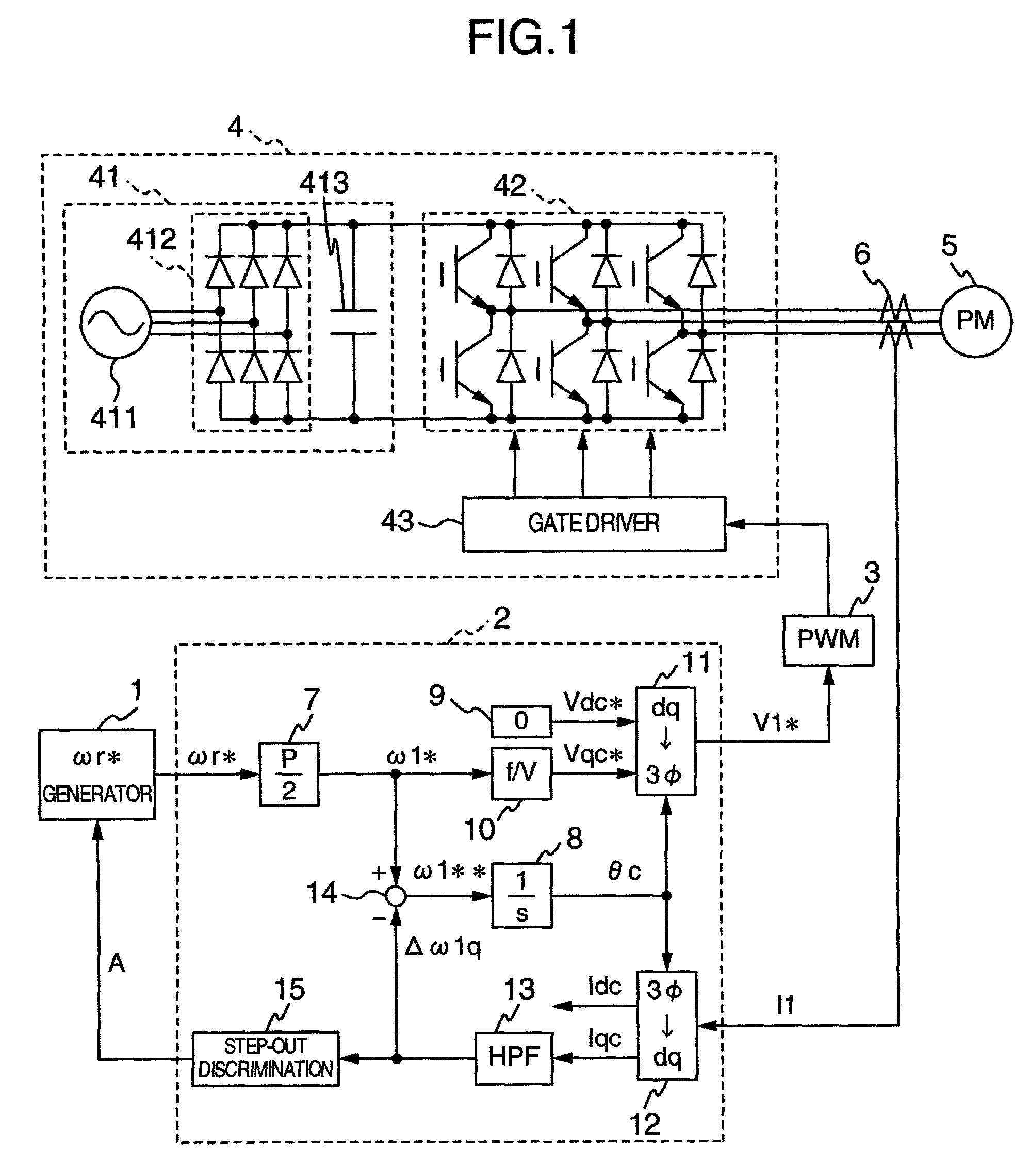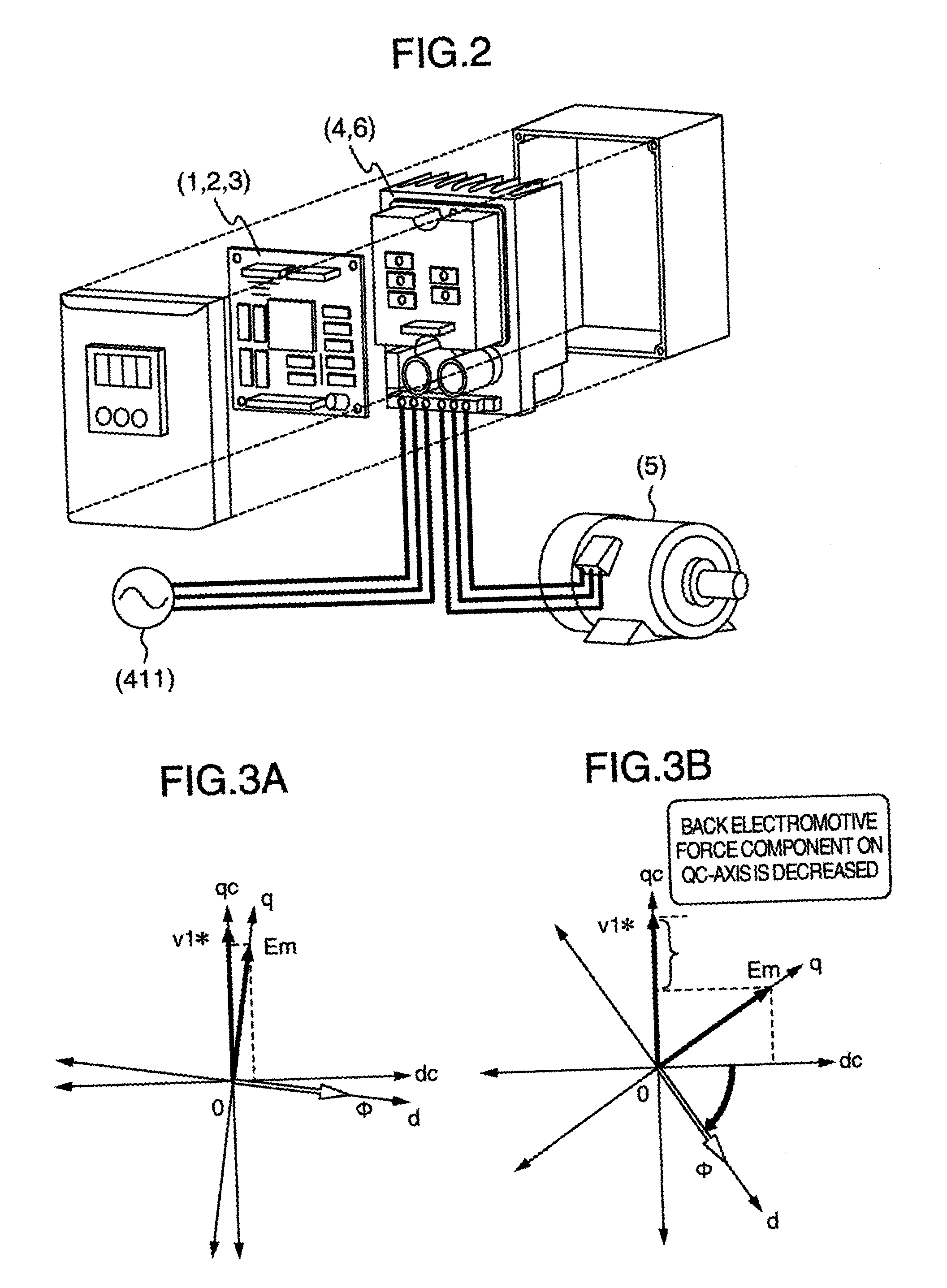System for driving electric motor
a technology of electric motor and system, applied in the direction of motor/generator/converter stopper, dynamo-electric gear control, dynamo-electric converter control, etc., can solve the problems of step-out detection, method of determining effective value, condition setting
- Summary
- Abstract
- Description
- Claims
- Application Information
AI Technical Summary
Problems solved by technology
Method used
Image
Examples
first embodiment
[0033] FIG. 1 is a circuit diagram, partly in block diagram, showing a configuration of a system for driving a permanent magnet type synchronous motor according to the present invention. In FIG. 1, reference numeral 1 designates a speed command generator for issuing a rotational speed command .omega.r* to an electric motor; reference numeral 2 designates a controller for operating arithmetically applied voltages to the electric motor; reference numeral 3 designates a PWM (Pulse Width Modulated Wave) generator for generating a pulse used to drive an inverter 4 on the basis of a voltage command V1*; reference numeral 4, the inverter for driving the electric motor; reference numeral 5, a permanent magnet type synchronous motor as a subject of the control; and 6, a current detector for detecting currents of the electric motor 5.
[0034] The controller 2 includes a conversion gain (P is the number of poles of the electric motor) 7 for converting the rotational speed command .omega.r* to an...
second embodiment
[0048] FIG. 6 shows the present invention.
[0049] As for the method of driving the permanent magnet type synchronous motor in the speed / position sensorless manner, there is known the sensorless / vector control method. In the case of the sensorless / vector control method, the d-q axes with the magnetic pole axis of the electric motor as the reference matches stationarily the dc-qc-axes in the controller, and hence it is possible to realize the linearity, the optimization of the efficiency, and the like. The second embodiment of the present invention relates to the step-out detection in this sensorless / vector control method.
[0050] FIG. 6 shows a configuration of the sensorless / vector controller having the step-out detector provided therein. A controller 2A shown in FIG. 6 is employed instead of the controller 2 shown in FIG. 1, whereby it is possible to realize the second embodiment of the present invention.
[0051] In FIG. 6, the constituent elements designated with reference numerals 7 t...
third embodiment
[0064] FIG. 7 shows the present invention.
[0065] Though since in the above-mentioned first and second embodiments, the step-out detection is carried out using .DELTA..omega.1q and .DELTA..theta.c which are changed in the step-out, the certainty of the step-out discrimination is enhanced, there arises the following problem. That is, when the load disturbance is very large and hence the rotation of the electric motor is stopped in an instant, the back electromotive force of the electric motor becomes zero at a stretch so that the vibration phenomenon of the above-mentioned .DELTA..omega.1q or .DELTA..theta.c does not occur. In other words, the above-mentioned first and second embodiments are not suitable for the use in which the electric motor gets into the step-out by the abruptly applied load to be stopped. In the third embodiment of the present invention, the step-out detecting method with which the above-mentioned problem is solved is provided.
[0066] In FIG. 7, the constituent ele...
PUM
 Login to View More
Login to View More Abstract
Description
Claims
Application Information
 Login to View More
Login to View More - R&D
- Intellectual Property
- Life Sciences
- Materials
- Tech Scout
- Unparalleled Data Quality
- Higher Quality Content
- 60% Fewer Hallucinations
Browse by: Latest US Patents, China's latest patents, Technical Efficacy Thesaurus, Application Domain, Technology Topic, Popular Technical Reports.
© 2025 PatSnap. All rights reserved.Legal|Privacy policy|Modern Slavery Act Transparency Statement|Sitemap|About US| Contact US: help@patsnap.com



